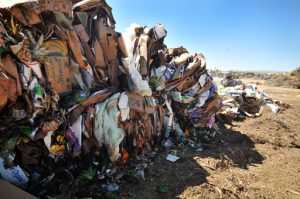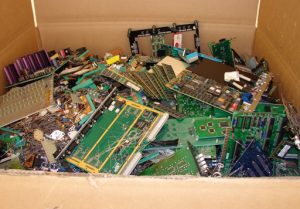Sandia goes beyond basic recycling of common papers, plastics, and metals. We divert as many waste streams for recycling as feasible. The list of materials diverted grows every year. We regularly re-evaluate processes for efficiency and improved revenues as well. Revenue received from recycling goes back into the program to fund material streams that currently cost to process, and to improve and expand the waste reduction infrastructure.
To maintain constant improvement, Sandia/New Mexico has performed three Recycling Opportunity Assessments to understand the status of our current recycling processes, and to identify and prioritize ways to improve and expand the processes and types of material diverted for recycle or composting. Reports were completed at the end of FY04, FY09, and FY13.
The state of New Mexico has a target to recycle 35% of its waste by 2018. The Department of Energy has a goal of 50% by 2015. Sandia/New Mexico is contributing toward both of these goals by recycling 65% of its waste in FY13. Sandia/California is doing even better at 80%.
Composting
 Sandia/New Mexico sends green waste in the form of branches to Kirtland Air Force Base’s mulching program. Additionally, sensitive documents are destroyed onsite and the remains are sent locally for composting. In 2010-2011, the green waste and composting efforts began and expanded greatly.
Sandia/New Mexico sends green waste in the form of branches to Kirtland Air Force Base’s mulching program. Additionally, sensitive documents are destroyed onsite and the remains are sent locally for composting. In 2010-2011, the green waste and composting efforts began and expanded greatly.
To reduce green waste going to the landfill, two large rolloff containers were strategically placed on campus to receive any green waste not eligible to be mulched (leaves, grass, trimmings). When full, these containers are hauled to a local composting facility. As needed, finished compost is simultaneously purchased by the truckload to save on return transportation. To reduce the volume of grass clippings and leaves, campus landscapers purchased two new mulching lawnmowers using recycling revenue.
Building on momentum from a 2009 waste audit, a six-month pilot of food waste composting from the main dining facility was completed in 2010 — it diverted more than 25% of the facility’s waste. The pilot was converted into an ongoing contract, and at Earth Day 2011 it expanded to the satellite café on campus. Diversion continues to improve, most recently reaching 66% of the two facilities’ waste.
Electronics
 If computer and laboratory equipment don’t find a reuse at Sandia, audited pathways exist to move the material offsite to be reused by other federal agencies, donated to New Mexico K-12 schools, sold at a local auction, or recycled domestically.
If computer and laboratory equipment don’t find a reuse at Sandia, audited pathways exist to move the material offsite to be reused by other federal agencies, donated to New Mexico K-12 schools, sold at a local auction, or recycled domestically.
Computers, peripherals, and accessories for recycling go to e-Steward Certified facilities. Circuit boards are sent to a domestic precious metals recovery vendor. Currently being explored is the diversion of hard drive magnets for the capture and sale of the neodymium (“rare earth”) material.
In 2011, Sandia/New Mexico won the Federal Electronics Challenge (FEC) Silver award for its efforts regarding the life-cycle approach to computers, including recycling.